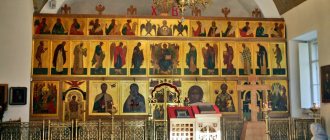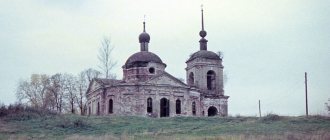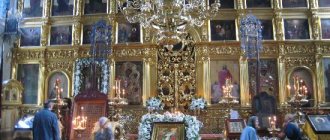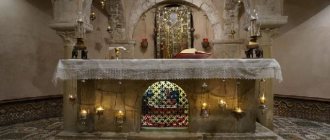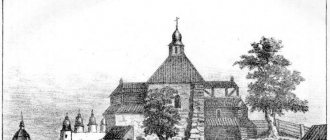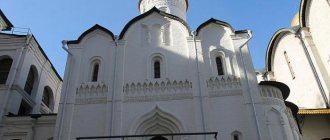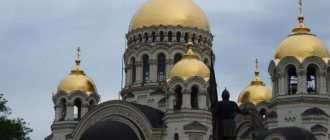This long-suffering church is somehow surprisingly located between three lanes: Novovogankovsky and two Trekhgorny. The Church of St. Nicholas on the Three Mountains has changed its name more than once over its centuries-old history and has been rebuilt several times. In the chronicles of 1628, its ancestor is mentioned - the Church of St. Nicholas in Psary. It received this name due to the transfer of the Royal Kennel Court here in the middle of the 17th century. This parish church community moved around the city several times, and, surprisingly, always took the church with them, which is probably why for some time it was called the “Church of St. Nicholas on a Chicken Leg.”
History of construction
There is a rather interesting story connected with the Church of St. Nicholas, which became known not so long ago. The fact is that during the years of Soviet power, Alexander Alexandrov served in the temple with the rank of regent, who later became famous as the author of the anthem of the Soviet Union.
Church of St. Nicholas on Three Mountains, Moscow
It is worth noting that there are quite a lot of such amazing facts about the life of the temple. Today, the Church of St. Nicholas on the Three Mountains is an architectural landmark of the 19th century. It was built in the 18th century in the Three Mountains tract in the place where there once was a temple in Novy Vagankovo.
Gradually, the temple was upset and took on a different appearance from the original one; moreover, by the end of the 19th century, the temple and the temple area were increased several times. The stone temple already had three altars, and by the beginning of the 20th century a large refectory and a new bell tower were added to it.
Interesting! Due to the fact that the new buildings that appeared were quite different from the architecture of the church, at the beginning of the 20th century it was decided once again to completely rebuild it. The project of the new temple was developed by Georgy Kaiser, and in 1902 the church was completely rebuilt and consecrated.
However, the fate of the newly erected temple was predetermined - in the 20s the church was looted, and its building itself was rebuilt in such a way that it could be used for the needs of society. The bell tower and domes of the temple were completely destroyed; for many years, a club began to be located in this place of prayer, and then a House of Culture for children named after Pavlik Morozov.
Church of St. Nicholas the Wonderworker
The same workers of the Trekhgornaya manufactory saved the church from disastrous destruction. In the most turbulent and dangerous years of 1905 and 1917, they organized the security of the cathedral, which was located right at the epicenter of all the revolutionary events that took place on Presnya. Thanks to this, the temple was not looted and destroyed.
However, in the early 20s, the church could not be saved; first it was destroyed, and then completely closed. In 1929 it was rebuilt; the dome and bell tower were destroyed. The new government placed a club there, and a little later the house of pioneers named after. Pavlik Morozova. The lane, which had the name Nikolsky, also began to bear the name of the pioneer hero.
Description
There is some disagreement regarding the architectural style to which the temple belongs. In general, we can say that the Church of St. Nicholas on Three Hills combines both the features of classicism, the main ones of which are the modesty and severity of details, and some features of the so-called “Moscow” baroque.
Interior of the Church of St. Nicholas
The long-awaited thaw
And now, after the collapse of the USSR, the Moscow government signed an order to return the building and its adjacent territory to the ownership of the Russian Orthodox Church.
The Church of St. Nicholas on the Three Mountains was immediately subjected to a major restoration and restored to its original beauty. Today it operates, even a Bible college, a Sunday school, and a club for the reconstruction of medieval folk cultures are open.
You can visit this temple at the address: Moscow, Novovagankovsky Lane, building 9, bldg. 1. The rector is now Archpriest Dmitry Roshchin, appointed on February 11, 2021.
Activities of the parish
Today there is a Sunday school at the church. Also at the temple there is a club for the reconstruction of medieval culture.
Important! The rector of the church, Dmitry Roshchin, has an active social position and heads the work with public organizations that are part of the Synodal Department of the Moscow Patriarchate for relations between the Church and society.
Schedule of services
On Wednesdays, Fridays and Saturdays, the church holds morning services at 8 a.m. and evening services at 5 p.m. On holidays and Sundays, morning liturgy begins at 9.00, evening liturgy at 18.00. Every week on Wednesdays at 18.00 an akathist to St. Nicholas the Wonderworker is read.
Shrines
Among the most revered shrines of the temple today, the most famous are the following:
- a particle of the holy relics of Nicholas of Myra;
- the icon of St. Nicholas the Wonderworker and a particle of his holy relics, located in the St. Nicholas chapel of the temple;
- icon of the Holy Martyr Tatiana and her holy relics;
- icon of the Great Martyr Panteleimon, painted in 1909 on Mount Athos.
Temple icon of St. Nicholas
Patronal holidays
In addition to general church Orthodox holidays, such as the Nativity of Christ and Easter, the church celebrates annually on May 22 an important patronal holiday - the transfer of the relics of St. Nicholas the Wonderworker.
There are several other dates associated with the life and death of St. Nicholas - September 11 and December 19, respectively.
St. Nicholas Church
Temple in the 17th century
The history of the Church of St. Nicholas on the Three Mountains begins with the wooden church of St. Nicholas in Psary, mentioned in chronicles since 1628. Its name is associated with the Sovereign Psarny yard, which was responsible for hunting and the royal menageries, which in 1637 was transferred from the western wall of the Kremlin to Three mountains.
Metrics of the Church of St. Nicholas on the Three Mountains, in New Vagankovo. Opinions also differ about the origin of the name “Vagankovo”. According to legend, the tsar's Little Russian hounds used vagans - large troughs hollowed out in wood - to prepare food, for which they themselves were nicknamed vagans, and their place of residence was Vagankovo. Settlement on Presnya in the 17th century. was named New Vagankovo, and the settlement behind the Kutafya Tower remained Old Vagankovo.
True, there is another version of the origin of the toponym. This part of Moscow was located at the intersection of two major roads - Znamenka, leading to Novgorod, and Arbat, leading to the western lands. In the 15th century a village arose here, in which the Sovereign's amusement court was organized. Traveling artists and musicians, who were then called vagantes, flocked to him, just like wandering poet-bards in medieval Europe.
There is information that in 1695 the temple began to be rebuilt by the Duma clerk Gavriil Feodorovich Derevnin, who lived nearby, who also built the famous stone church of St. Elijah the Common on Ostozhenka.
XVIII – early XX centuries
In the first half of the 18th century. Three Mountains is becoming a summer cottage for wealthy Muscovites. Over time, rich “dacha residents” turn into permanent residents of New Vagankov and are assigned to St. Nicholas parish.
It was at this time that permission was received to build a stone church on the site of a wooden one: according to some sources it dates back to May 1763, according to others - 1762. In any case, the new temple was small. But in subsequent years it was expanded several times, adding chapels - first to St. Demetrius, Metropolitan of Rostov, and then, in 1785, in the name of the icon of the Mother of God “Life-Giving Source”.
In 1799, next to the St. Nicholas Church on the banks of the Moscow River, merchant Vasily Prokhorov and dyer Fyodor Rezanov founded a calico-printing factory, which over time became the famous Trekhgornaya Manufactory.
Vasily Ivanovich Prokhorov (1755-1815), merchant of the 3rd guild, founder of the dynasty of Moscow industrialists, was born into a peasant family assigned to the Trinity-Sergius Lavra. Until 1771 he worked as a brewing clerk. However, he left this occupation, “incompatible with Christian piety,” and took up calico printing. Over time, V.I. Prokhorov became the sole owner of the manufactory, buying out Fyodor Rezanov’s share.
Project for the reconstruction of the temple, architect Kaiser G.A., 1900. For almost a hundred years, until 1896, the Prokhorovs were ktitors and trustees of St. Nicholas Church. Their activities left a noticeable mark on the church life of Moscow. Industrialists also engaged in charity work, establishing hospitals and shelters for orphans and homeless people.
After the cholera epidemic of 1848, in gratitude for getting rid of it, it was decided to rebuild the St. Nicholas Church. By the end of 1860, the temple had a large refectory and a high bell tower, its area increased two and a half times. The construction was carried out with the money of parishioners.
In the second half of the 19th century. Through the tireless pastoral efforts of the rector, Archpriest Ruf Rzhanitsyn and his successor, Priest Evgeniy Uspensky, St. Nicholas parish became the largest in Moscow. Evening and morning services were performed in the church every day, and on Sundays and holidays three liturgies were served. The parish carried out active patronage and social activities. In 1861, a Board of Trustees was created at the temple, which collected information about poor parishioners and provided them with assistance. Father Ruf also founded the first two-year parish school for women in Moscow, by the beginning of the 20th century. Almost 90 pupils studied there.
Project of the northern façade, architect Kaiser G.A., 1900. The constant increase in the number of parishioners required another major reconstruction of the temple. It began in 1900 based on the project of the famous architect Georgy Alexandrovich Kaiser (1860-1931), approved personally by Emperor Nicholas II.
Funds for the work were allocated by the Kopeikin-Serebryakov family, owners of a large retail company. The rebuilt church was re-consecrated on December 1, 1902, but the reconstruction was completely completed only in 1908. The design of the G. A. Kaiser temple also formed the basis for restoration work in 1991-2000.
The events of 1905, the center of which was Presnya, as well as the October Revolution of 1917, miraculously did not affect the life of St. Nicholas parish. Its numbers remained stable, and order around the temple was maintained by the workers of Trekhgorka themselves - the parishioners of the temple.
XX-XXI century
In the spring of 1922, St. Nicholas Church, like all Moscow churches and monasteries, experienced a campaign to confiscate church valuables, losing more than 12 pounds of gold and silver objects. At this time, one of the regents of the temple was Alexander Vasilyevich Alexandrov, later the author of the USSR anthem and the founder of the Song and Dance Ensemble of the Soviet Army.
In 1928, the Church of St. Nicholas on Three Mountains, despite numerous requests from believers, was closed. By the end of 1930, the domes were removed from the church, openings were cut in the walls, and the upper tiers of the bell tower were dismantled. The building was adapted first as a House of Culture, and then as a House of Pioneers named after Pavlik Morozov.
On July 7, 1992, the Moscow Government adopted Resolution No. 472 on the provision of a plot of land in the village for permanent use. No. 9 on Pavlik Morozov Lane (now Novovagankovsky) to the parish of the Church of St. Nicholas on Three Mountains of the Moscow Diocese of the Russian Orthodox Church. Regular services resumed in 2001. A Sunday school was established at the church.
The especially revered shrines of the temple include a reliquary with a particle of the relics of St. Nicholas of Myra, taken out from the altar on Sundays and holidays, an icon of the Wonderworker with a particle of his relics, located in the St. Nicholas chapel, as well as an image of the Holy Martyr Tatiana with a particle of relics in the central part of the temple and an icon The Holy Great Martyr and Healer Panteleimon in the chapel of St. Demetrius of Rostov, written in 1909 in St. Andrew's Skete on Athos.
Since February 2021, the rector of the Temple has been Archpriest Dimitry Roshchin, who at the same time heads the department for work with public organizations at the Synodal Department of the Moscow Patriarchate for relations between the Church and society.
Materials
- Old Vagankovo and the former Pashkov house (historical and topographical information) by N. A. Yanchuk
- Historical and archaeological description of the Church of St. Nicholas the Wonderworker, on Znamenka in Moscow [Text] / comp. I. Tokmakov. - Moscow: Gubernskaya typ., 1893
- Fiftieth anniversary of the Rumyantsev Museum in Moscow. 1862-1912: East. feature article. — Moscow: t-vo skoropech. A.A. Levenson, 1913
- Fiftieth anniversary of the Moscow 4th gymnasium (1849-1899): Krat. ist. essay / Comp. dir. Gymnasium D. Sokolov. — Moscow: type. "Rus. t-va oven and ed. affairs", 1899
- Fiftieth anniversary of the Rumyantsev Museum in Moscow. 1862-1912: East. feature article. — Moscow: t-vo skoropech. A.A. Levenson, 1913
- Plans of the lower and middle floors of the Pashkov House and adjacent buildings [text] / Moscow Public and Rumyantsev Museums. - [B. m.]: con. XIX - early XX century — 2 ll.
- Temple of the Rumyantsov Museum: [Hist. feature article]. — Moscow: Guardianship Council at the Rumyantsov Church. museum, 1906
Current status[ | ]
In 1992, a decree was signed by the Moscow government on the return of the building and the adjacent territory to the Russian Orthodox Church[1]. During the almost ten-year restoration, the building was restored to its original form. Currently, the temple is operational; a Sunday school conducts classes in the building located on the territory.
A new large-scale restoration began in 2021 [4]. They plan to bring the temple in accordance with the drawings of the 19th century, and not only the external elements will be recreated, but also the interiors, including wall paintings and the iconostasis.
